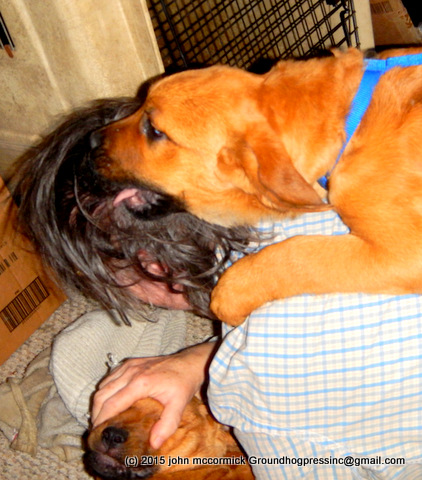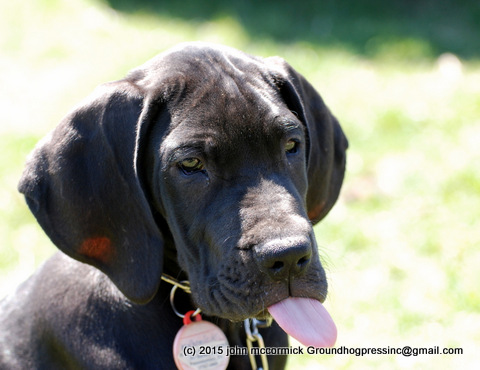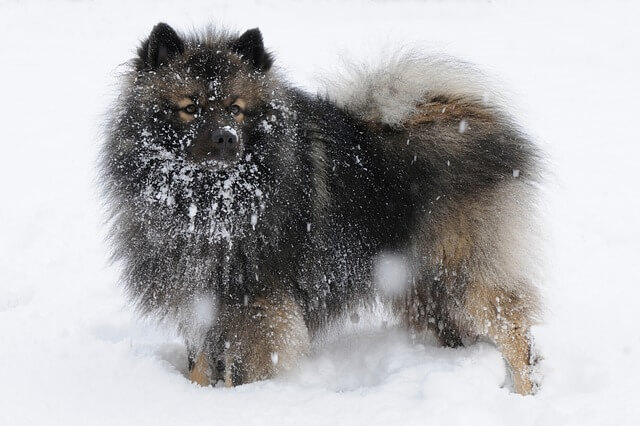Studies of various dogs’ facial expressions and how they change in carefully staged conditions have shown that when they see a human they raise their eyebrows.
More importantly, if their little eye spies their owner instead of some other human the dog will do something that shows what they are thinking is really true love.

Abby 8 weeks old
That thing, saved for their owner is that they will tend to raise the left eyebrow more than the right.
Of course that only counts if they have eyebrows and you can see them.
On some large breeds like this Great Dane they mostly just seem sad.
If, on the other hand, the human the dog sees is a stranger this will often cause the animal to pull their ears back a bit as a sign of caution.
Showing a dog something they are afraid of or an object which they really don’t like such as a pair of nail clippers (or probably a bathtub!) will can cause the dog’s right ear to twitch.
Although the above is all from recent scientific research, I probably should mention that most of the rest of this article depends on my knowledge of and interest in dogs which includes some psychology but goes a bit beyond academic research. I’m a Koehler Method trainer for aggressive dogs and use reward-based methods for more laid back breeds, including clicker training which I’m currently using on my St. Weiler puppies. BTW, I also had classes in behavioral psychology, including operant conditioning (this is complex and includes BOTH reward and negative methods), etc., in college. As it happened it was the same school where Behavioral psychology was developed.
I’ve lived with dogs my whole life before and after a few mandatory dog-free dormitory years. After moving out I had Newfoundland who lived on my boat and attended two universities with me. Hannah weighed in at 220 lb. when full grown but I adopted her from an animal rescue operation when she was only 10 weeks-old. I owned a Bouvier des Flandres kennel, rescued both Newfoundlands and Bouviers, and owned a ranch.
In other words, I’m not relying only (if at all) on reports from someone on the Web who may not even own a dog.
Because face and body language are important to the way dogs communicate with their people and with other dogs, docking their tails and cropping their ears may handicap them in life – it is something additional to consider when contemplating operating on your trusting puppy for cosmetic reasons.
Play position is probably the most recognizable puppy posture after tail wagging. If you ever had a puppy you must know what it is – rear up, head down, elbows on the floor/ground. All it takes to confirm this is an indication of a desire to play is to take the same position yourself – but be prepared to have a puppy land on your back.

Puppies playing with mistress
OR on your head!
A wagging tail by itself may not mean a happy dog – if it is baring its teeth don’t reach to pat it.
But if the dog isn’t showing any aggressive posture such as a lowered head, a wagging tail is definitely the indication of a happy dog. An open mouth showing teeth isn’t aggressive unless the lips are pulled back, the dog may just be cooling off.
Squinting of eyes generally means the dog is frightened or in pain. Larger than usual eyes as an expression rather than the natural appearance may be a sign of danger.
Need I point out that breed characteristics are critical in evaluating body and facial cues, some dogs have naturally large eyes while properly groomed Bouviers and some sheep dogs may have their eyes obscured by hair so you can’t learn anything from them. Any facial expressions and changes need to be evaluated beginning with a knowledge of what the dog should look like when relaxed.
A steady direct stare from any strange dog indicates aggression but if it is your dog or puppy staring into your eyes it is a sign of affection.

Non-threatening stare
This Saint Weiler is definitely NOT preparing to rip my head (or big toe) off.
If a dog is tense or rigid in appearance and you mostly see the white part of its eyes then be prepared for an attack – back off slowly. Of course if the dog is merely sleeping and wakes to glance at you sideways it means nothing.
In my experience with many small dogs when frightened they will often turn their head away from you but stare at you sideways while baring their teeth. Often they are so tense they don’t just shake, they almost vibrate. Nine times out of ten if you reach out to that dog you’ll get bit.
A wrinkled nose, especially if the dog is showing some teeth is also a bad sign.
In fact the general rule is if the dog looks relaxed than you can relax too. If it looks tense, back off.

Ziva, 8 weeks
Definitely NOT a threat!






Recent Comments